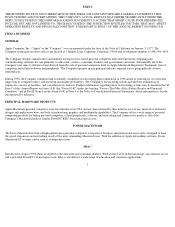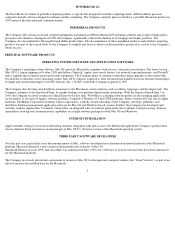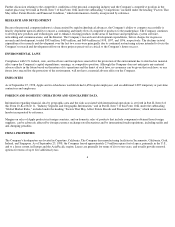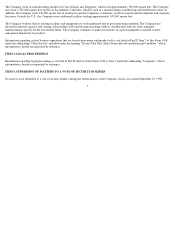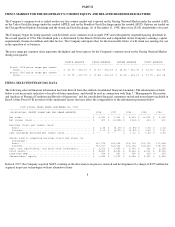Apple 1998 Annual Report Download - page 8
Download and view the complete annual report
Please find page 8 of the 1998 Apple annual report below. You can navigate through the pages in the report by either clicking on the pages listed below, or by using the keyword search tool below to find specific information within the annual report.Further discussion relating to the competitive conditions of the personal computing industry and the Company's competitive position in the
market place may be found in Part II, Item 7 of this Form 10-K under the subheading "Competition," included under the heading "Factors That
May Affect Future Results and Financial Condition," which information is hereby incorporated by reference.
RESEARCH AND DEVELOPMENT
Because the personal computer industry is characterized by rapid technological advances, the Company's ability to compete successfully is
heavily dependent upon its ability to ensure a continuing and timely flow of competitive products to the marketplace. The Company continues
to develop new products and technologies and to enhance existing products in the areas of hardware and peripherals, system software,
networking and communications, and the Internet. The Company's research and development expenditures, before charges for in-process
research and development, totaled $303 million, $485 million, and $604 million in 1998, 1997, and 1996, respectively. The declines in total
expenditures for research and development over the last two years were principally due to continued restructuring actions intended to focus the
Company's research and development efforts on those projects perceived as critical to the Company's future success.
ENVIRONMENTAL LAWS
Compliance with U.S. federal, state, and local laws and foreign laws enacted for the protection of the environment has to date had no material
effect upon the Company's capital expenditures, earnings, or competitive position. Although the Company does not anticipate any material
adverse effects in the future based on the nature of its operations and the thrust of such laws, no assurance can be given that such laws, or any
future laws enacted for the protection of the environment, will not have a material adverse effect on the Company.
EMPLOYEES
As of September 25, 1998, Apple and its subsidiaries worldwide had 6,658 regular employees, and an additional 3,005 temporary or part-time
contractors and employees.
FOREIGN AND DOMESTIC OPERATIONS AND GEOGRAPHIC DATA
Information regarding financial data by geographic area and the risks associated with international operations is set forth in Part II, Item 8 of
this Form 10-K at Note 11, "Industry Segment and Geographic Information," and in Part II, Item 7 of this Form 10-K under the subheading
"Global Market Risks," included under the heading "Factors That May Affect Future Results and Financial Condition," which information is
hereby incorporated by reference.
Margins on sales of Apple products in foreign countries, and on domestic sales of products that include components obtained from foreign
suppliers, can be adversely affected by foreign currency exchange rate fluctuations and by international trade regulations, including tariffs and
anti-dumping penalties.
ITEM 2. PROPERTIES
The Company's headquarters are located in Cupertino, California. The Company has manufacturing facilities in Sacramento, California, Cork,
Ireland, and Singapore. As of September 25, 1998, the Company leased approximately 2.9 million square feet of space, primarily in the U.S.,
and to a lesser extent, in Europe and the Asia/Pacific region. Leases are generally for terms of five to ten years, and usually provide renewal
options for terms of up to five additional years.
6



